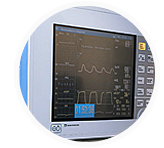Maximizing capabilities
Successful UX solutions help integrating workflows, providing clinical assessment support, and improving monitoring. However, many of these components can be overlooked when the focus is solely on documentation. Clinical teams should be encouraged to take the leap from merely registering data to using intelligent UX solutions.
Power of Visualization
Straight forward workflows and intuitive UI enhance user experience. With improvements in visualization, it has become clear that successful UX solutions help providing access to data when it is needed and in the most usable format. Innovations in user interfaces and mobile technology support it through dynamic dashboards and adaptive visuals.
Improving Safety
The safe and correct use of medical devices can be noticeably improved when proven human factors methods are integrated early and applied during the design process. The additional expenses to do so are often insignificant, but the return can be remarkable. Enhanced user satisfaction and reduced use-related errors are often the outcomes.
Improving Clinical Outcomes
Healthcare organizations that have embraced innovative UX solutions have seen improved productivities as well as enhanced clinical and operational outcomes. Pragmatic UX strategy is crucial in increasing patient safety and providing better quality of care, leading to improved business results and a reduction of unnecessary treatments and interventions. Enhanced workflow, monitoring, access to information, as well as compliance with guidelines and regulations contribute to improved outcomes.



Human Factors in Medical Device Design
The application of knowledge about human behavior, abilities, limitations, and other technical characteristics of medical device users when designing medical devices, including mechanical and software-driven user interfaces, systems, tasks, user documentation, and user training, to demonstrate and enhance safe and effective use.
The process of assessing, at one or more stages during the product development process, a user interface or user interactions with the user interface in order to identify the interface’s strengths and weaknesses and to identify potential use errors that would or could result in harm to the patient or user. Patient safety will improve as future medical devices are designed to comply with the formative evaluation process.
Testing conducted at the end of the product development process to assess user interactions with a product user interface and to identify use errors that may result in serious harm to the patient or user. Human factors validation testing is also used to assess the effectiveness of risk management measures. Human factors validation testing represents one portion of design validation. Human factors, as a scientific, systems-focused discipline, is poised to identify and solve many of the medical systems’ problems in general and device-related limitations in particular.
The AAMI Human Factors Engineering Committee developed the process-oriented standard to provide manufacturers with a methodology to user interface design, helping to develop safe and usable medical devices. It also helps responding to the increasing number of human factors standards in the medical field and governmental regulations concerning to medical device UI design.
The Health Insurance Portability and Accountability Act (HIPAA) Security Rule establishes national standards to protect individuals’ electronic personal health information. The Security Rule requires appropriate administrative, physical, and technical safeguards to ensure the confidentiality, integrity, and security of electronic protected health information. We help organizations better understand and implement the HIPAA requirements in their operational environment.
An analytical method to identify use errors associated with each use step, and then the hazards/risks and clinical significance of those hazards/risks. The use-related risk analysis includes a comprehensive and systematic evaluation of all the steps involved in using the product, the errors that users might commit or the tasks they might fail to perform, the potential negative clinical consequences of use errors, the mitigation strategies, and methods for validating the risk mitigation strategies. The study of human factors is established in the principles obtained through experimental and cognitive research.
Agile Approach
Working in agile environment helps achieving a greater degree of collaboration. Rapid brainstorming sessions allow to find right answers and develop a solution without the delay of inefficient documentation. Stakeholders' reviews occur when one of the many iterations is released, and the resulting input is taken into account as the next iteration is scheduled.
Lean UX
Lean UX is focused on rapid product iterations, team collaboration and prompt decision making, rather than traditional deliverables. Lean UX is based on validated learning. The goal is to learn as quickly as possible, by validating design decisions with users and incorporating the iterations to develop the optimal results.
Usability and Accessibility
We use innovative techniques for conducting user-centered research for medical applications to promote health information technology (HIT) usability standards and evaluation criteria.
Strategic Innovation
User experience strategy involves a thorough synthesis of business approach and UX design. We utilize practical methodology and proven techniques when developing products for healthcare industry.
Streamlined Workflows
Successful UXD moves emphasis from interface to patient. While medical applications are becoming more perceptive and efficient, they are also should be practical, intuitive, and easy-to use.
Regulatory Requirements
All medical products are subject to a wide range of regulations, therefore quality, reliability and safety remain paramount when designing devices that care providers rely on to help save patients’ lives.
REACHING GLOBAL MARKETS
SELECTED CLIENTS:







